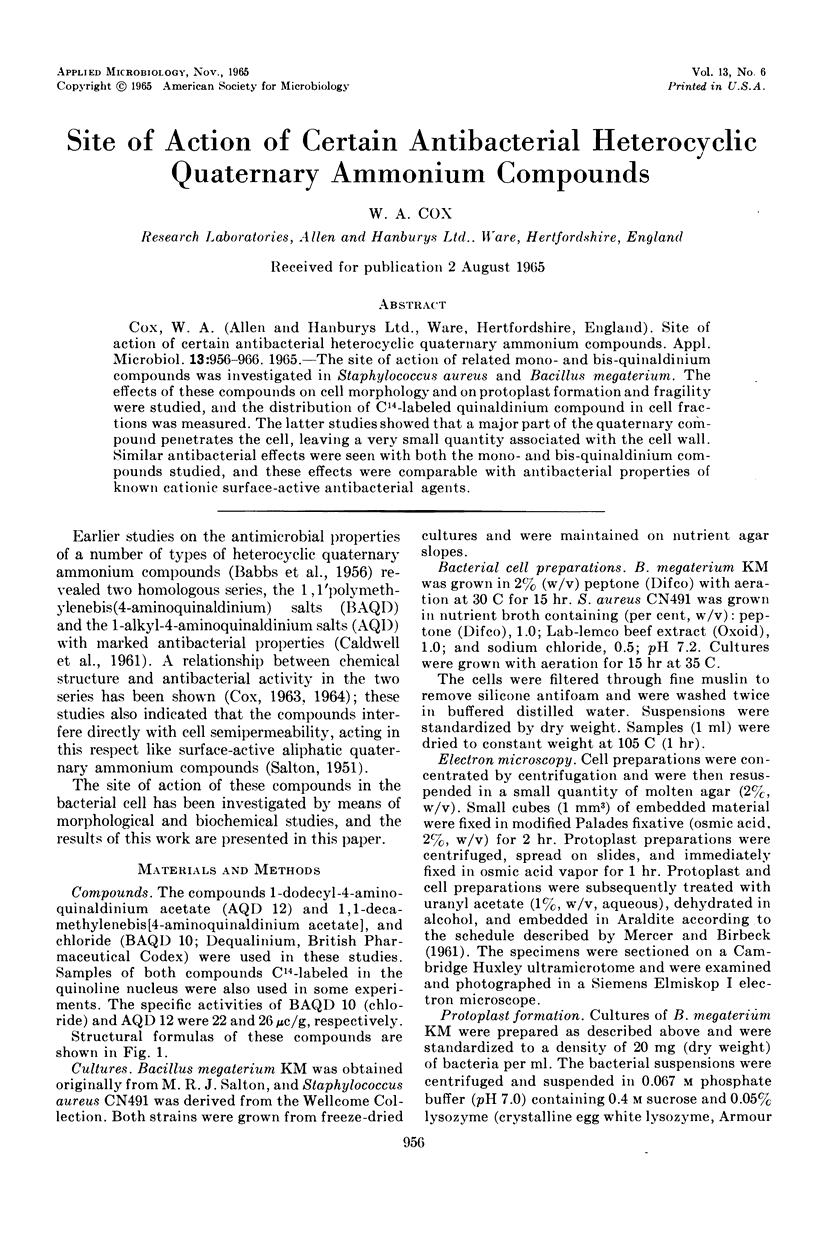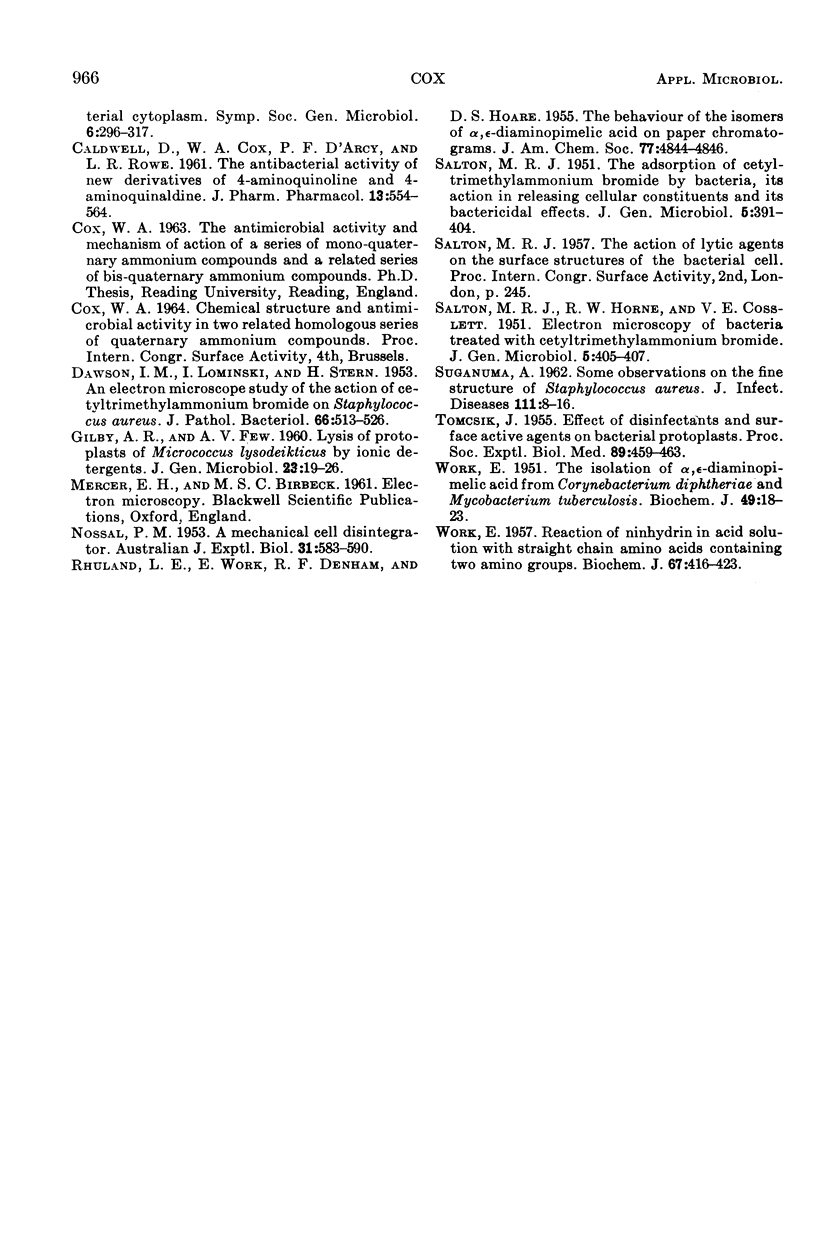Abstract
The site of action of related mono- and bis-quinaldinium compounds was investigated in Staphylococcus aureus and Bacillus megaterium. The effects of these compounds on cell morphology and on protoplast formation and fragility were studied, and the distribution of C14-labeled quinaldinium compound in cell fractions was measured. The latter studies showed that a major part of the quaternary compound penetrates the cell, leaving a very small quantity associated with the cell wall. Similar antibacterial effects were seen with both the mono- and bis-quinaldinium compounds studied, and these effects were comparable with antibacterial properties of known cationic surface-active antibacterial agents.
Full text
PDF










Images in this article
Selected References
These references are in PubMed. This may not be the complete list of references from this article.
- BABBS M., COLLIER H. O., AUSTIN W. C., POTTER M. D., TAYLOR E. P. Salts of decamethylene-bis-4-aminoquinaldinium (dequadin); a new antimicrobial agent. J Pharm Pharmacol. 1956 Feb;8(2):110–119. doi: 10.1111/j.2042-7158.1956.tb12138.x. [DOI] [PubMed] [Google Scholar]
- CALDWELL D., COX W. A., D'ARCY P. F., ROWE L. R. The antibacterial activity of new derivatives of 4-aminoquinoline and 4-aminoquinaldine. J Pharm Pharmacol. 1961 Sep;13:554–564. doi: 10.1111/j.2042-7158.1961.tb11869.x. [DOI] [PubMed] [Google Scholar]
- DAWSON I. M., LOMINSKI I., STERN H. An electron-microscope study of the action of cetyl-trimethyl-ammonium bromide on Staphylococcus aureus. J Pathol Bacteriol. 1953 Oct;66(2):513–526. doi: 10.1002/path.1700660223. [DOI] [PubMed] [Google Scholar]
- GILBY A. R., FEW A. V. Lysis of protoplasts of Micrococcus lysodeikticus by ionic detergents. J Gen Microbiol. 1960 Aug;23:19–26. doi: 10.1099/00221287-23-1-19. [DOI] [PubMed] [Google Scholar]
- NOSSAL P. M. A mechanical cell disintegrator. Aust J Exp Biol Med Sci. 1953 Dec;31(6):583–589. doi: 10.1038/icb.1953.64. [DOI] [PubMed] [Google Scholar]
- SALTON M. R. J., HORNE R. W., COSSLETT V. E. Electron microscopy of bacteria treated with cetyltrimethylammonium bromide. J Gen Microbiol. 1951 May;5(2):405–407. doi: 10.1099/00221287-5-2-405. [DOI] [PubMed] [Google Scholar]
- SALTON M. R. J. The adsorption of cetyltrimethylammonium bromide by bacteria, its action in releasing cellular constituents and its bactericidal effects. J Gen Microbiol. 1951 May;5(2):391–404. doi: 10.1099/00221287-5-2-391. [DOI] [PubMed] [Google Scholar]
- SUGANUMA A. Some observations on the fine structure of Staphylococcus aureus. J Infect Dis. 1962 Jul-Aug;111:8–16. doi: 10.1093/infdis/111.1.8. [DOI] [PubMed] [Google Scholar]
- TOMCSIK J. Effect of disinfectants and of surface active agents on bacterial protoplasts. Proc Soc Exp Biol Med. 1955 Jul;89(3):459–463. doi: 10.3181/00379727-89-21844. [DOI] [PubMed] [Google Scholar]
- WORK E. Reaction of ninhydrin in acid solution with straight-chain amino acids containing two amino groups and its application to the estimation of alpha epsilon-diaminopimelic acid. Biochem J. 1957 Nov;67(3):416–423. doi: 10.1042/bj0670416. [DOI] [PMC free article] [PubMed] [Google Scholar]
- WORK E. The isolation of alpha epsilon-Diaminopimelic acid from Corynebacterium diphtheriae and Mycobacterium tuberculosis. Biochem J. 1951 Jun;49(1):17–23. doi: 10.1042/bj0490017. [DOI] [PMC free article] [PubMed] [Google Scholar]










